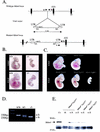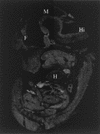Mdm4 (Mdmx) regulates p53-induced growth arrest and neuronal cell death during early embryonic mouse development
- PMID: 12101245
- PMCID: PMC133932
- DOI: 10.1128/MCB.22.15.5527-5538.2002
Mdm4 (Mdmx) regulates p53-induced growth arrest and neuronal cell death during early embryonic mouse development
Abstract
We report here the characterization of a mutant mouse line with a specific gene trap event in the Mdm4 locus. Absence of Mdm4 expression results in embryonic lethality (10.5 days postcoitum [dpc]), which was rescued by transferring the Mdm4 mutation into a Trp53-null background. Mutant embryos were characterized by overall growth deficiency, anemia, improper neural tube closure, and dilation of lateral ventricles. In situ analysis demonstrated increased levels of p21(CIP1/Waf1) and lower levels of Cyclin E and proliferating cell nuclear antigen expression. Consistent with lack of 5-bromo-2'-deoxyuridine incorporation, these data suggest a block of mutant embryo cells in the G(1) phase of the cell cycle. Accordingly, Mdm4-deficient mouse embryonic fibroblasts manifested a greatly reduced proliferative capacity in culture. Moreover, extensive p53-dependent cell death was specifically detected in the developing central nervous system of the Mdm4 mutant embryos. These findings unambiguously assign a critical role for Mdm4 as a negative regulator of p53 and suggest that Mdm4 could contribute to neoplasias retaining wild-type Trp53. Finally, we provide evidence indicating that Mdm4 plays no role on cell proliferation or cell cycle control that is distinct from its ability to modulate p53 function.
Figures






References
-
- Angerer, L. M., and R. C. Angerer. 1991. Localizations of mRNAs by in situ hybridisation. Methods Cell Biol. 35:37-71. - PubMed
-
- Aolad, H. M., M. Inouye, W. Darmanto, S. Hayasaka, and Y. Marata. 2000. Hydrocephalus in mice following X-irradiation at early gestational stage, possibly due to persistent deceleration of cell proliferation. J. Radiat. Res. 41:213-226. - PubMed
-
- Boyd, S. D., K. Y. Tsai, and T. Jacks. 2000. An intact HDM2 RING-finger domain is required for nuclear exclusion of p53. Nat. Cell Biol. 2:563-568. - PubMed
-
- Brugarolas, J., C. Chandrasekaran, J. I. Gordon, D. Beach, T. Jacks, and G. J. Hannon. 1995. Radiation-induced cell cycle arrest compromised by p21 deficiency. Nature 377:552-557. - PubMed
-
- Daujat, S., H. Neel, and J. Piette. 2001. MDM2: life without p53. Trends Genet. 17:459-464. - PubMed
Publication types
MeSH terms
Substances
LinkOut - more resources
Full Text Sources
Other Literature Sources
Molecular Biology Databases
Research Materials
Miscellaneous
